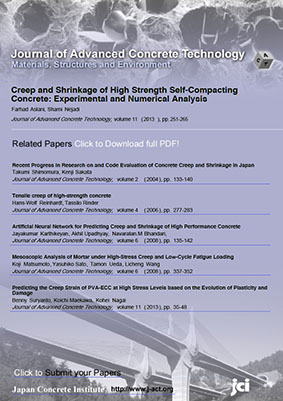
- |<
- <
- 1
- >
- >|
-
Alisher Ismailov, Kanat Baybolov, Raimberdi Ristavletov, Bakhadyr Kopz ...2018 年 16 巻 9 号 p. 429-440
発行日: 2018/09/14
公開日: 2018/09/14
ジャーナル フリーWe have investigated the effects of secondary raw materials content on the hydration of slag-cement mixtures. We focus on the important issue of studying cost-effective alkaline additives in binder mixtures based on phosphorus slag. We have analyzed the main phases in slag and ash and found that the most common phase was slag glass. This phase has considerable hydraulic properties due to high latent energy if we compare them to compare to those of the holocrystalline phase of the same compound. The process of adding small amounts of alkali and sulfates to vitreous slag activates its latent hydraulic properties. The effect of alkaline activators creates an alkaline environment required for the reactions between slag glass components. This article provides a way of determining the composition of raw mixtures and ensuring the possibility of correcting it, as well as a method for determining the proper (in terms of quality of concrete) pH value.
抄録全体を表示PDF形式でダウンロード (4591K) -
Yuichiro Kawabata, Kazuo Yamada, Yasutaka Sagawa, Shoichi Ogawa2018 年 16 巻 9 号 p. 441-460
発行日: 2018/09/14
公開日: 2018/09/14
ジャーナル フリーA new testing protocol, Alkali-Wrapped Concrete Prism Test (AW-CPT), is proposed to avoid alkali leaching and drying, which considerably influence expansion behavior of concrete affected by alkali-silica reaction (ASR). The approach used in this test is that a concrete specimen is wrapped by wet cloth containing alkali solution mimicking the alkalinity of the concrete pore solution. The proposed testing protocol was validated through laboratory and field-exposure measurements, with a focus on expansion, alkali mass balance, and mass change. The test results clearly showed that alkali leaching and drying were significantly reduced by using the AW-CPT method. AW-CPT gives a conservative threshold total alkali content, while conventional CPT overestimates it. The test results also highlighted that there may be an optimum condition of temperature and level of alkali boosting for each reactive aggregate.
抄録全体を表示PDF形式でダウンロード (1210K) -
Nguyen Xuan Quy, Junho Kim, Yukio Hama2018 年 16 巻 9 号 p. 461-475
発行日: 2018/09/27
公開日: 2018/09/27
ジャーナル フリーThe objective of this study was to determine the influence of environmental conditions on the pore structure of mortar. For this purpose, the experimental program was designed with the following two series: Series 1 included both a 10-year outdoor exposure test set and a laboratory test set and Series 2 included only a laboratory test set. The pore structure of mortar specimens was evaluated using the Mercury Intrusion Porosimetry method. In general, the pore structure change due to temperature in both the outdoor exposure test and the laboratory test showed the same tendency. The test results confirmed that the pore structure of mortar coarsened and that the volume of pores with a diameter range of 40 to 2000 nm increased due to the increase in temperature and the decrease in relative humidity. Furthermore, this paper reports evidence for the relationship between pore structure change and maturity, and an improved maturity function is proposed. The change in the pore structure is determined by the proposed maturity function, which considers the curing temperature history and the relative humidity. The relative humidity is an additional and novel factor forming the new maturity function for the prediction of pore structure change.
抄録全体を表示PDF形式でダウンロード (1299K) -
Hailong Ye2018 年 16 巻 9 号 p. 476-484
発行日: 2018/09/27
公開日: 2018/09/27
ジャーナル フリーIn this work, the effect of magnesia (MgO) on the hydrated phase assemblage, microstructure, as well as drying and carbonation shrinkage of hardened Portland cement paste is studied. By means of X-ray diffraction, scanning electron microscopy (SEM/EDS), and thermodynamic simulation, it shows that MgO hydration does not substantially alter the phase assemblage and microstructure of hardened cement paste, except the formation of brucite. The 5% MgO addition reduces the drying shrinkage of cement by about half, which cannot be simply explained by the molar volumetric increase due to MgO to brucite conversion. The results suggest that besides generating early-age expansion offsetting subsequent drying shrinkage, the formed brucite at early stages can enhance the matrix stiffness probably due to crystal formation with reinforcing potentials. In addition, the MgO addition improves the carbonation resistance of hardened cement due to the formation of magnesium-containing calcium carbonates. However, the effectiveness of MgO in mitigating carbonation shrinkage depends on the drying and carbonation sequence.
抄録全体を表示PDF形式でダウンロード (4147K) -
Jun Zhang, Xuan Zheng, Qing Wang2018 年 16 巻 9 号 p. 485-497
発行日: 2018/09/27
公開日: 2018/09/27
ジャーナル フリーIn this paper, mixture optimization on internally cured high strength engineered cementitious composite (HSECC) with pre-wetted sand-like zeolite is conducted based on shrinkage and mechanical performance tests. Experimental study on the effect of the replacing ratio of the cement with the calcined zeolite on matrix compressive and bending strength was carried out first. Based on above test results, four optimized mixtures with the zeolite addition of 144, 194, 244 and 294 kg/m3 were obtained. Shrinkage and uniaxial tensile tests on the four high strength matrix reinforced with 2% PVA and 1% steel fibers were conducted. Through mixture optimization, strength of cement matrix with the calcined zeolite addition is further improved. The optimized replacing ratio of cement with the zeolite in the matrix is existed to obtain the highest compressive and bending strength. Shrinkage the HSECC with optimized addition of the calcined zeolite is significantly reduced. The highest reduction rate on shrinkage of the composite comparing to the reference achieves 78%. Tensile performance with optimized addition of the calcined zeolite is improved comparing with the reference mixture as well. Four optimized mixtures of HSECC are obtained with cracking and tensile strength, ultimate tensile strain and average crack width at tensile strength achieving of 4.31 - 5.48 MPa and 6.36 - 7.27 MPa, 1.01 - 1.27% and 18 - 24 μm.
抄録全体を表示PDF形式でダウンロード (1204K)
- |<
- <
- 1
- >
- >|